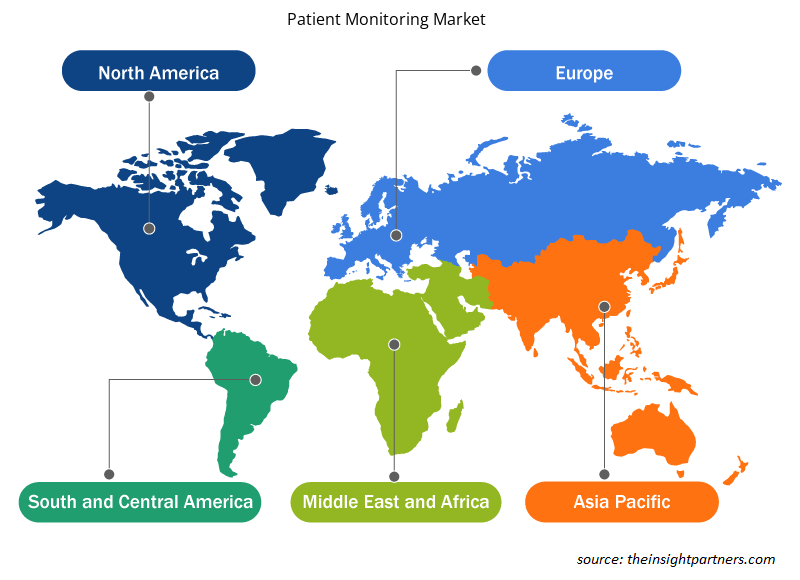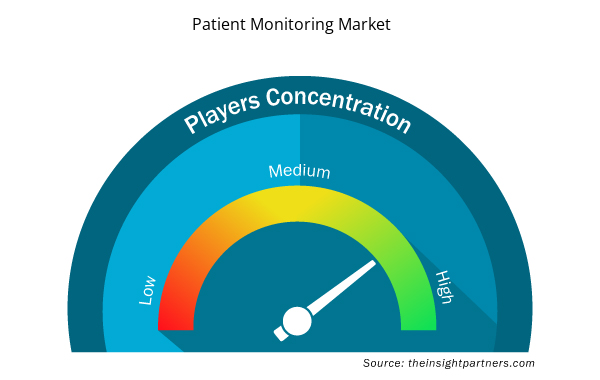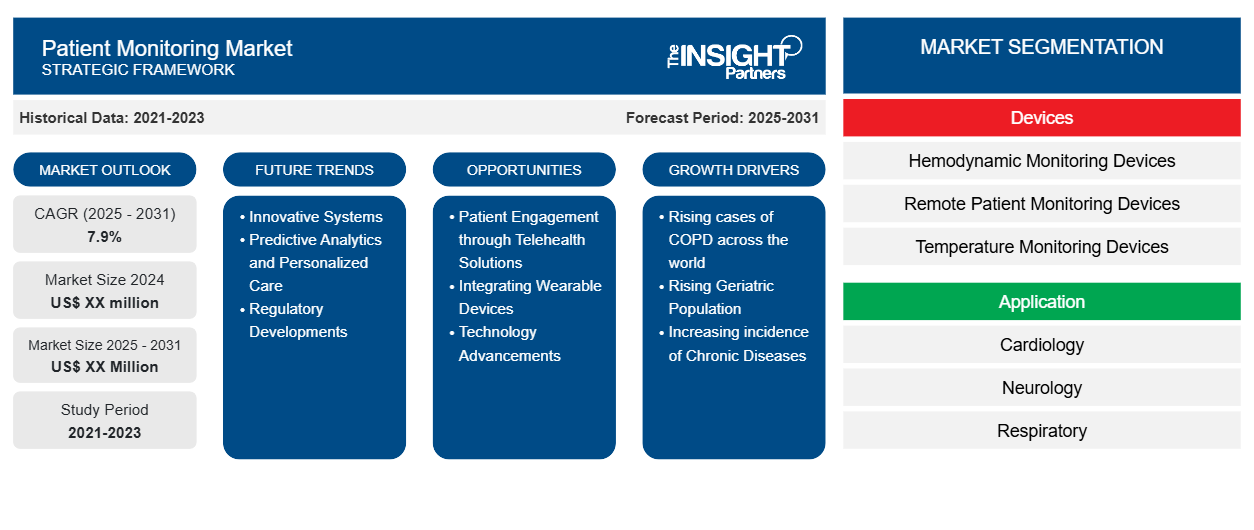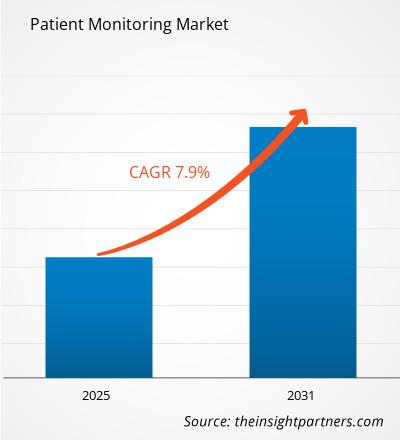Le marché de la surveillance des patients devrait enregistrer un TCAC de 7,9 % de 2023 à 2031, avec une taille de marché passant de XX millions USD en 2023 à XX millions USD d'ici 2031.
Le rapport est segmenté par surveillance des patients par dispositifs (dispositifs de surveillance hémodynamique, dispositifs de surveillance à distance des patients, dispositifs de surveillance de la température, dispositifs de neurosurveillance, dispositifs de surveillance cardiaque, dispositifs de surveillance respiratoire, dispositifs de surveillance multiparamétrique et autres), application (cardiologie, neurologie, respiratoire, fœtale et néonatale, gestion du poids et surveillance de la condition physique et autres applications), utilisateur final (soins de santé à domicile, hôpitaux et cliniques et autres utilisateurs finaux) et géographie (Amérique du Nord, Europe, Asie-Pacifique, Moyen-Orient et Afrique, et Amérique du Sud et centrale). L'analyse globale est ensuite décomposée au niveau régional et par principaux pays. Le rapport offre la valeur en USD pour l'analyse et les segments ci-dessus.
Objectif du rapport
Le rapport Patient Monitoring Market de The Insight Partners vise à décrire le paysage actuel et la croissance future, les principaux facteurs moteurs, les défis et les opportunités. Cela fournira des informations à diverses parties prenantes commerciales, telles que :
- Fournisseurs/fabricants de technologie : pour comprendre l’évolution de la dynamique du marché et connaître les opportunités de croissance potentielles, leur permettant de prendre des décisions stratégiques éclairées.
- Investisseurs : Effectuer une analyse complète des tendances concernant le taux de croissance du marché, les projections financières du marché et les opportunités qui existent tout au long de la chaîne de valeur.
- Organismes de réglementation : Réglementer les politiques et surveiller les activités du marché dans le but de minimiser les abus, de préserver la confiance des investisseurs et de maintenir l’intégrité et la stabilité du marché.
Segmentation du marché de la surveillance des patients
Appareils
- Dispositifs de surveillance hémodynamique
- Dispositifs de surveillance à distance des patients
- Dispositifs de surveillance de la température
- Dispositifs de neuromonitoring
- Dispositifs de surveillance cardiaque
- Appareils de surveillance respiratoire
- Dispositifs de surveillance multiparamètres
- Autres
Application
- Cardiologie
- Neurologie
- Respiratoire
- Fœtal et néonatal
- Gestion du poids et suivi de la condition physique
- Autres applications
Utilisateur final
- Soins à domicile
- Hôpitaux et cliniques
- Autres utilisateurs finaux
Géographie
- Amérique du Nord
- Europe
- Asie-Pacifique
- Amérique du Sud et Amérique centrale
- Moyen-Orient et Afrique
Géographie
- Amérique du Nord
- Europe
- Asie-Pacifique
- Amérique du Sud et Amérique centrale
- Moyen-Orient et Afrique
Personnalisez ce rapport en fonction de vos besoins
Vous bénéficierez d'une personnalisation gratuite de n'importe quel rapport, y compris de certaines parties de ce rapport, d'une analyse au niveau des pays, d'un pack de données Excel, ainsi que d'offres et de remises exceptionnelles pour les start-ups et les universités.
- Obtenez les principales tendances clés du marché de ce rapport.Cet échantillon GRATUIT comprendra une analyse de données, allant des tendances du marché aux estimations et prévisions.
Facteurs de croissance du marché de la surveillance des patients
- Augmentation des cas de BPCO dans le monde : Le nombre de cas de BPCO devrait augmenter de 112 millions pour atteindre un total de 592 millions d'ici 2050 (9,5 % de la population totale éligible), soit une augmentation relative de 23,3 % entre 2020 et 2050. En 2024, le cancer du sein est le cancer le plus courant en Inde, représentant 28,2 % de tous les cancers féminins, avec environ 216 108 cas d'ici 2022
- Augmentation de la population gériatrique : la population âgée de 60 ans et plus était estimée à 1 milliard en 2020. D'ici 2050, la population mondiale de personnes âgées de 60 ans et plus doublera (2,1 milliards). Le nombre de personnes âgées de 80 ans et plus devrait tripler entre 2020 et 2050 pour atteindre 426 millions.
- Incidence croissante des maladies chroniques : plus de la moitié (51,8 %) des adultes souffrent d’au moins une des dix maladies chroniques diagnostiquées (arthrite, cancer, bronchopneumopathie chronique obstructive, maladie coronarienne, asthme, diabète, hépatite, hypertension, accident vasculaire cérébral et insuffisance rénale). Environ 21 % des personnes âgées en Inde souffriraient d’au moins une maladie chronique.
Tendances futures du marché de la surveillance des patients
- Systèmes innovants : les entreprises conçoivent actuellement des systèmes innovants plus conviviaux et moins invasifs, garantissant aux patients la surveillance dont ils ont besoin sans gêne inutile. L'accent sera mis en priorité sur l'expérience du patient et l'amélioration de la qualité des soins.
- Analyse prédictive et soins personnalisés : dans le paysage en constante évolution des infrastructures de santé, l’analyse prédictive représente un espoir, transformant la manière dont les organisations fournissent des soins personnalisés. Par exemple, le Mount Sinai Health System a mis en œuvre une modélisation prédictive pour identifier les patients à risque de développer des maladies chroniques et aiguës.
- Évolution réglementaire : Les Centers for Medicare & Medicaid Services (CMS) ont élargi l'accès aux services de télésanté, entraînant une augmentation de 63 % des visites de télésanté rien qu'en 2020. Des entreprises comme Teladoc Health ont joué un rôle crucial, signalant plus de 4 millions de visites virtuelles au cours du premier trimestre 2021.
Opportunités de marché pour la surveillance des patients
- Engagement des patients grâce aux solutions de télésanté : en utilisant des appels vidéo et des services de chat, la clinique maintient non seulement la continuité des soins, mais établit également un sentiment de confiance et de communication plus profond avec ses patients. La plupart des études suggèrent que la télémédecine est rentable, active les patients et leur permet de rester dans leur environnement naturel aussi longtemps qu'ils ne le pouvaient pas.
- Intégration d'appareils portables : les utilisateurs ont déclaré se sentir plus motivés à faire de l'exercice régulièrement et à adopter un mode de vie plus sain, ce qui démontre l'impact positif que ces appareils peuvent avoir sur le bien-être général d'un patient. Des fonctionnalités telles que des compteurs de pas, des moniteurs de fréquence cardiaque et des dispositifs de suivi du sommeil permettent aux patients de recueillir facilement des données sur leurs comportements et habitudes quotidiennes.
- Progrès technologiques : Ces dernières années, le secteur de la santé a été transformé par l’émergence de nouvelles technologies de surveillance à distance des patients (RPM). Philips en est un parfait exemple : il a développé un système RPM basé sur le cloud qui permet aux prestataires de soins de santé de surveiller les patients atteints de maladies chroniques depuis leur domicile.
Aperçu régional du marché de la surveillance des patients
Les tendances régionales et les facteurs influençant le marché de la surveillance des patients tout au long de la période de prévision ont été expliqués en détail par les analystes d’Insight Partners. Cette section traite également des segments et de la géographie du marché de la surveillance des patients en Amérique du Nord, en Europe, en Asie-Pacifique, au Moyen-Orient et en Afrique, ainsi qu’en Amérique du Sud et en Amérique centrale.

- Obtenez les données régionales spécifiques au marché de la surveillance des patients
Portée du rapport sur le marché de la surveillance des patients
| Attribut de rapport | Détails |
|---|---|
| Taille du marché en 2023 | XX millions de dollars américains |
| Taille du marché d'ici 2031 | XX millions de dollars américains |
| Taux de croissance annuel composé mondial (2023-2031) | 7,9% |
| Données historiques | 2021-2022 |
| Période de prévision | 2024-2031 |
| Segments couverts | Par appareils
|
| Régions et pays couverts | Amérique du Nord
|
| Leaders du marché et profils d'entreprises clés |
|
Densité des acteurs du marché de la surveillance des patients : comprendre son impact sur la dynamique commerciale
Le marché de la surveillance des patients connaît une croissance rapide, tirée par la demande croissante des utilisateurs finaux en raison de facteurs tels que l'évolution des préférences des consommateurs, les avancées technologiques et une plus grande sensibilisation aux avantages du produit. À mesure que la demande augmente, les entreprises élargissent leurs offres, innovent pour répondre aux besoins des consommateurs et capitalisent sur les tendances émergentes, ce qui alimente davantage la croissance du marché.
La densité des acteurs du marché fait référence à la répartition des entreprises ou des sociétés opérant sur un marché ou un secteur particulier. Elle indique le nombre de concurrents (acteurs du marché) présents sur un marché donné par rapport à sa taille ou à sa valeur marchande totale.
Les principales entreprises opérant sur le marché de la surveillance des patients sont :
- Honeywell International, Inc
- Philips Santé
- Smiths Médical
- Medtronic
- Abbott
Avis de non-responsabilité : les sociétés répertoriées ci-dessus ne sont pas classées dans un ordre particulier.

- Obtenez un aperçu des principaux acteurs du marché de la surveillance des patients
Principaux arguments de vente
- Couverture complète : Le rapport couvre de manière exhaustive l’analyse des produits, des services, des types et des utilisateurs finaux du marché de la surveillance des patients, offrant un paysage holistique.
- Analyse d’experts : Le rapport est compilé sur la base d’une compréhension approfondie des experts et analystes du secteur.
- Informations à jour : Le rapport garantit la pertinence commerciale en raison de sa couverture des informations récentes et des tendances des données.
- Options de personnalisation : ce rapport peut être personnalisé pour répondre aux exigences spécifiques du client et s'adapter parfaitement aux stratégies commerciales.
Le rapport de recherche sur le marché de la surveillance des patients peut donc aider à ouvrir la voie au décodage et à la compréhension du scénario de l’industrie et des perspectives de croissance. Bien qu’il puisse y avoir quelques préoccupations valables, les avantages globaux de ce rapport ont tendance à l’emporter sur les inconvénients.
- Analyse historique (2 ans), année de base, prévision (7 ans) avec TCAC
- Analyse PEST et SWO
- Taille du marché Valeur / Volume - Mondial, Régional, Pays
- Industrie et paysage concurrentiel
- Ensemble de données Excel



Report Coverage
Revenue forecast, Company Analysis, Industry landscape, Growth factors, and Trends

Segment Covered
This text is related
to segments covered.

Regional Scope
North America, Europe, Asia Pacific, Middle East & Africa, South & Central America

Country Scope
This text is related
to country scope.
Questions fréquemment posées
Rising Geriatric Population
Technological Advancements
Europe held the second largest share in terms of revenue in 2023
Technical expertise is one of the key challenges faced by the overall market
The patient monitoring market is anticipated to witness a CAGR of 7.9% during the forecast period.
Asia Pacific region is expected to witness the highest growth during the forecast period
The List of Companies
1. Honeywell International, Inc
2. Philips Healthcare
3. Smiths Medical
4. Medtronic
5. Abbott
6. Omron Corporation
7. Lifewatch AG
8. Roche Diagnostics
9. Boston Scientific Corporation
10. Nihon Kohden Corporation
11. SCHILLER
12. DEXCOM, INC.
13. SHENZHEN MINDRAY BIO-MEDICAL ELECTRONICS
14. NONIN
15. DRÄGERWERK AG & CO. KGAA
The Insight Partners performs research in 4 major stages: Data Collection & Secondary Research, Primary Research, Data Analysis and Data Triangulation & Final Review.
- Data Collection and Secondary Research:
As a market research and consulting firm operating from a decade, we have published and advised several client across the globe. First step for any study will start with an assessment of currently available data and insights from existing reports. Further, historical and current market information is collected from Investor Presentations, Annual Reports, SEC Filings, etc., and other information related to company’s performance and market positioning are gathered from Paid Databases (Factiva, Hoovers, and Reuters) and various other publications available in public domain.
Several associations trade associates, technical forums, institutes, societies and organization are accessed to gain technical as well as market related insights through their publications such as research papers, blogs and press releases related to the studies are referred to get cues about the market. Further, white papers, journals, magazines, and other news articles published in last 3 years are scrutinized and analyzed to understand the current market trends.
- Primary Research:
The primarily interview analysis comprise of data obtained from industry participants interview and answers to survey questions gathered by in-house primary team.
For primary research, interviews are conducted with industry experts/CEOs/Marketing Managers/VPs/Subject Matter Experts from both demand and supply side to get a 360-degree view of the market. The primary team conducts several interviews based on the complexity of the markets to understand the various market trends and dynamics which makes research more credible and precise.
A typical research interview fulfils the following functions:
- Provides first-hand information on the market size, market trends, growth trends, competitive landscape, and outlook
- Validates and strengthens in-house secondary research findings
- Develops the analysis team’s expertise and market understanding
Primary research involves email interactions and telephone interviews for each market, category, segment, and sub-segment across geographies. The participants who typically take part in such a process include, but are not limited to:
- Industry participants: VPs, business development managers, market intelligence managers and national sales managers
- Outside experts: Valuation experts, research analysts and key opinion leaders specializing in the electronics and semiconductor industry.
Below is the breakup of our primary respondents by company, designation, and region:

Once we receive the confirmation from primary research sources or primary respondents, we finalize the base year market estimation and forecast the data as per the macroeconomic and microeconomic factors assessed during data collection.
- Data Analysis:
Once data is validated through both secondary as well as primary respondents, we finalize the market estimations by hypothesis formulation and factor analysis at regional and country level.
- Macro-Economic Factor Analysis:
We analyse macroeconomic indicators such the gross domestic product (GDP), increase in the demand for goods and services across industries, technological advancement, regional economic growth, governmental policies, the influence of COVID-19, PEST analysis, and other aspects. This analysis aids in setting benchmarks for various nations/regions and approximating market splits. Additionally, the general trend of the aforementioned components aid in determining the market's development possibilities.
- Country Level Data:
Various factors that are especially aligned to the country are taken into account to determine the market size for a certain area and country, including the presence of vendors, such as headquarters and offices, the country's GDP, demand patterns, and industry growth. To comprehend the market dynamics for the nation, a number of growth variables, inhibitors, application areas, and current market trends are researched. The aforementioned elements aid in determining the country's overall market's growth potential.
- Company Profile:
The “Table of Contents” is formulated by listing and analyzing more than 25 - 30 companies operating in the market ecosystem across geographies. However, we profile only 10 companies as a standard practice in our syndicate reports. These 10 companies comprise leading, emerging, and regional players. Nonetheless, our analysis is not restricted to the 10 listed companies, we also analyze other companies present in the market to develop a holistic view and understand the prevailing trends. The “Company Profiles” section in the report covers key facts, business description, products & services, financial information, SWOT analysis, and key developments. The financial information presented is extracted from the annual reports and official documents of the publicly listed companies. Upon collecting the information for the sections of respective companies, we verify them via various primary sources and then compile the data in respective company profiles. The company level information helps us in deriving the base number as well as in forecasting the market size.
- Developing Base Number:
Aggregation of sales statistics (2020-2022) and macro-economic factor, and other secondary and primary research insights are utilized to arrive at base number and related market shares for 2022. The data gaps are identified in this step and relevant market data is analyzed, collected from paid primary interviews or databases. On finalizing the base year market size, forecasts are developed on the basis of macro-economic, industry and market growth factors and company level analysis.
- Data Triangulation and Final Review:
The market findings and base year market size calculations are validated from supply as well as demand side. Demand side validations are based on macro-economic factor analysis and benchmarks for respective regions and countries. In case of supply side validations, revenues of major companies are estimated (in case not available) based on industry benchmark, approximate number of employees, product portfolio, and primary interviews revenues are gathered. Further revenue from target product/service segment is assessed to avoid overshooting of market statistics. In case of heavy deviations between supply and demand side values, all thes steps are repeated to achieve synchronization.
We follow an iterative model, wherein we share our research findings with Subject Matter Experts (SME’s) and Key Opinion Leaders (KOLs) until consensus view of the market is not formulated – this model negates any drastic deviation in the opinions of experts. Only validated and universally acceptable research findings are quoted in our reports.
We have important check points that we use to validate our research findings – which we call – data triangulation, where we validate the information, we generate from secondary sources with primary interviews and then we re-validate with our internal data bases and Subject matter experts. This comprehensive model enables us to deliver high quality, reliable data in shortest possible time.


 Obtenez un échantillon gratuit pour ce rapport
Obtenez un échantillon gratuit pour ce rapport